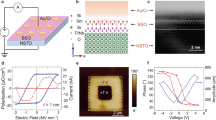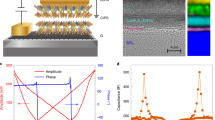Abstract
Ferroelectric tunnel junctions (FTJs), composed of two metal electrodes separated by an ultrathin ferroelectric barrier, have attracted much attention as promising candidates for non-volatile resistive memories. Theoretical1,2,3,4 and experimental5,6,7,8,9 works have revealed that the tunnelling resistance switching in FTJs originates mainly from a ferroelectric modulation on the barrier height. However, in these devices, modulation on the barrier width is very limited, although the tunnelling transmittance depends on it exponentially as well10. Here we propose a novel tunnelling heterostructure by replacing one of the metal electrodes in a normal FTJ with a heavily doped semiconductor. In these metal/ferroelectric/semiconductor FTJs, not only the height but also the width of the barrier can be electrically modulated as a result of a ferroelectric field effect11,12, leading to a greatly enhanced tunnelling electroresistance. This idea is implemented in Pt/BaTiO3/Nb:SrTiO3 heterostructures, in which an ON/OFF conductance ratio above 104, about one to two orders greater than those reported in normal FTJs, can be achieved at room temperature6,9,13,14,15,16,17,18. The giant tunnelling electroresistance, reliable switching reproducibility and long data retention observed in these metal/ferroelectric/semiconductor FTJs suggest their great potential in non-destructive readout non-volatile memories.
This is a preview of subscription content, access via your institution
Access options
Subscribe to this journal
Receive 12 print issues and online access
$259.00 per year
only $21.58 per issue
Buy this article
- Purchase on Springer Link
- Instant access to full article PDF
Prices may be subject to local taxes which are calculated during checkout



Similar content being viewed by others
References
Tsymbal, E. Y. & Kohlstedt, H. Tunneling across a ferroelectric. Science 313, 181–183 (2006).
Kohlstedt, H., Pertsev, N. A., Contreras, J. R. & Waser, R. Theoretical current–voltage characteristics of ferroelectric tunnel junctions. Phys. Rev. B 72, 125341 (2005).
Zhuravlev, M. Y., Sabirianov, R. F., Jaswal, S. S. & Tsymbal, E. Y. Giant electroresistance in ferroelectric tunnel junctions. Phys. Rev. Lett. 94, 246802 (2005).
Pantel, D. & Alexe, M. Electroresistance effects in ferroelectric tunnel barriers. Phys. Rev. B 82, 134105 (2010).
Garcia, V. et al. Giant tunnel electroresistance for non-destructive readout of ferroelectric states. Nature 460, 81–84 (2009).
Chanthbouala, A. et al. Solid-state memories based on ferroelectric tunnel junctions. Nature Nanotech. 7, 101–104 (2012).
Gruverman, A. et al. Tunneling electroresistance effect in ferroelectric tunnel junctions at the nanoscale. Nano Lett. 9, 3539–3543 (2009).
Crassous, A. et al. Giant tunnel electroresistance with PbTiO3 ferroelectric tunnel barriers. Appl. Phys. Lett. 96, 042901 (2010).
Pantel, D. et al. Tunnel electroresistance in junctions with ultrathin ferroelectric Pb(Zr0.2Ti0.8)O3 barriers. Appl. Phys. Lett. 100, 232902 (2012).
Griffiths, D. Introduction to Quantum Mechanics (Pearson Prentice Hall, 2005).
Mathews, S., Ramesh, R., Venkatesan, T. & Benedetto, J. Ferroelectric field effect transistor based on epitaxial perovskite heterostructures. Science 276, 238–240 (1997).
Miller, S. L. & McWhorter, P. J. Physics of the ferroelectric nonvolatile memory field effect transistor. J. Appl. Phys. 72, 5999–6010 (1992).
Garcia, V. et al. Ferroelectric control of spin polarization. Science 327, 1106–1110 (2010).
Gajek, M. et al. Tunnel junctions with multiferroic barriers. Nature Mater. 6, 296–302 (2007).
Pantel, D., Goetze, S., Hesse, D. & Alexe, M. Reversible electrical switching of spin polarization in multiferroic tunnel junctions. Nature Mater. 11, 289–293 (2012).
Hambe, M. et al. Crossing an interface: Ferroelectric control of tunnel currents in magnetic complex oxide heterostructures. Adv. Fun. Mater. 20, 2436–2441 (2010).
Yin, Y. W. et al. Coexistence of tunneling magnetoresistance and electroresistance at room temperature in La0.7Sr0.3MnO3/(Ba,Sr)TiO3/La0.7Sr0.3MnO3 multiferroic tunnel junctions. J. Appl. Phys. 109, 07D915 (2011).
Yin, Y. W. et al. Enhanced tunneling electroresistance effect due to a ferroelectrically induced phase transition at a magnetic complex oxide interface. Nature Mater. 12, 397–402 (2013).
Giaever, I. Energy gap in superconductors measured by electron tunneling. Phys. Rev. Lett. 5, 147–148 (1960).
Tedrow, P. M. & Meservey, R. Spin-dependent tunneling into ferromagnetic nickel. Phys. Rev. Lett. 26, 192–195 (1971).
Fong, D. D. et al. Ferroelectricity in ultrathin perovskite films. Science 304, 1650–1653 (2004).
Kim, Y. S. et al. Critical thickness of ultrathin ferroelectric BaTiO3 films. Appl. Phys. Lett. 86, 102907 (2005).
Esaki, L., Laibowitz, R. B. & Stiles, P. J. Polar switch. IBM Tech. Discl. Bull. 13, 2161–2162 (1971).
Chanthbouala, A. et al. A ferroelectric memristor. Nature Mater. 11, 860–864 (2012).
Kim, D. J. et al. Ferroelectric tunnel memristor. Nano Lett. 12, 5697–5702 (2012).
Sze, S. M. & Ng, K. K. Physics of Semiconductor Devices 3rd edn, Ch. 4 (Wiley, 2007).
Takizawa, M. et al. Angle-resolved photoemission study of Nb-doped SrTiO3 . Phys. Rev. B 79, 113103 (2009).
Choi, K. J. et al. Enhancement of ferroelectricity in strained BaTiO3 thin films. Science 306, 1005–1009 (2004).
Lu, H. et al. Enhancement of ferroelectric polarization stability by interface engineering. Adv. Mater. 24, 1209–1216 (2012).
Acknowledgements
This work was jointly sponsored by State Key Program for Basic Research of China (2009CB929503), Natural Science Foundation of China (51222206 and 91022001), and Natural Science Foundation of Jiangsu Province (BK2012016). Shanghai Synchrotron Radiation Facility is greatly acknowledged for providing the beam time and technical assistance. The authors would like to thank J. Yao and D. Beck from Asylum Research for valuable advice on PFM measurements.
Author information
Authors and Affiliations
Contributions
D.W. conceived this work and conducted the calculations. D.W. and Z.W. designed the experiment. Z.W. fabricated the devices and performed the measurements. Z.W., C.L., D.W., A.L. and N.M. analysed the data. Z.W. and D.W. wrote the manuscript. D.W. and N.M. directed the project. All authors discussed the data and contributed to the manuscript.
Corresponding author
Ethics declarations
Competing interests
The authors declare no competing financial interests.
Supplementary information
Supplementary Information
Supplementary Information (PDF 1447 kb)
Rights and permissions
About this article
Cite this article
Wen, Z., Li, C., Wu, D. et al. Ferroelectric-field-effect-enhanced electroresistance in metal/ferroelectric/semiconductor tunnel junctions. Nature Mater 12, 617–621 (2013). https://doi.org/10.1038/nmat3649
Received:
Accepted:
Published:
Issue Date:
DOI: https://doi.org/10.1038/nmat3649
This article is cited by
-
Performance improvement of a tunnel junction memristor with amorphous insulator film
Discover Nano (2023)
-
High-performance van der Waals antiferroelectric CuCrP2S6-based memristors
Nature Communications (2023)
-
Nanoscale multistate resistive switching in WO3 through scanning probe induced proton evolution
Nature Communications (2023)
-
Greatly enhanced tunneling electroresistance in ferroelectric tunnel junctions with a double barrier design
npj Computational Materials (2023)
-
In-plane ferroelectric tunnel junctions based on 2D α-In2Se3/semiconductor heterostructures
npj Computational Materials (2023)



